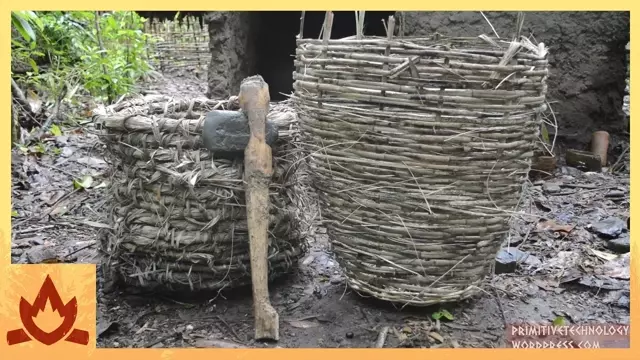2015-12-25
[public] 9.01M views, 120K likes, dislikes audio only
I made 2 types of basket and a celt hatchet. The first type of basket made was a coil basket. Bunches of palm leaves where wrapped in thin strips of lawyer cane to for a coil. This was then coiled into a spiral with each coil being tied to the last to keep it in place. This was done by sewing a new section of coil to the previous one. The basket was given a flat base so it could stand up but could be made any shape.
The second basket was made of lawyer cane. It started with thick strips of cane placed on the ground crossing in the centers to form an asterix shape. Importantly another half a lawyer strip was added so that the number of spokes the basket had was odd- even numbers don't work with this type of basket. The canes were tied together in the center with a strip of bark and a piece of cane was woven in a spiral around the spokes like a spider web. When the base was wide enough the spokes were bent up to form the vertical sides of the basket. The weaving continued up the walls to the top and the ends of the spokes folded down back into the basket.
The coil method was very time consuming (about a week on and off) and made a heavy basket but used simple materials and had few gaps in it. Long grass could be used instead of palm leaves and any type of ties could be used to bind the coils. This type of basket can look very neat if done carefully (the one I made was rough). Also I would add that circular or rectangular mats might be made using this method and these materials. This might provide thick padding against the ground for sitting and sleeping and when finished could be rolled up and stored out of the way.
The woven cane baskets were much faster to make (2 or 3 hours each including harvesting materials). They used fewer materials and were lighter too. I could have easily made them bigger but wanted them to fit through the narrow door of the tiled hut.
The baskets will be used mainly for storing charcoal inside huts out of the rain but are also useful for carrying leaf mulch for the garden. They have flat bases meaning they can stand upright and even be stacked on top of each other.
I also made a small celt hatchet for lighter work. The big celt I made is useful for chopping bigger trees but is overkill for saplings and smaller trees. The method used was basically the same for the big celt though this time I used no fire hardening. The handle came from a branch cleared from the the sweetpotato patch and had sat for a few months seasoning on the ground. It was much harder to shape than green wood but was hard enough to not need fire hardening. So far I've used it without the handle splitting though the basalt head chipped when trying to chop dry eucalyptus branches (an especially hard wood)- I re sharpened it and it works on other woods ok.
Wordpress: https://primitivetechnology.wordpress.com/
Patreon page: https://www.patreon.com/user?u=2945881&ty=h
I have no face book page. Beware of fake pages.
http://www.penguinrandomhouse.com/primitive-technology
/youtube/video/RzDMCVdPwnE
/youtube/video/mL3sho1CpkI?t=295
/youtube/channel/UCAL3JXZSzSm8AlZyD3nQdBA
/youtube/video/nG-rNHgFxhs
/youtube/video/TMzo9zjkuHc
http://www.penguinrandomhouse.com/primitive-technology

